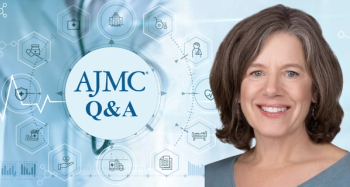
- June 2022
- Volume 28
- Issue 4
- Pages: SP162-SP163
COTA’s Miruna Sasu on Real-world Evidence: “The Ecosystem Has Changed”
Miruna Sasu, PhD, MBA, became president and CEO of COTA Healthcare in March 2022, not quite a year after joining the company as its chief strategy officer. As the importance of RWD grows, Sasu is ready to take its use in precision oncology to new levels. She spoke with Evidence-Based Oncology™ (EBO) about her new role.
Miruna Sasu, PhD, MBA, became president and CEO of COTA Healthcare in March 2022,1 not quite a year after joining the company as its chief strategy officer. COTA, founded in 2011 by physicians and data scientists who believed they could find ways to organize real-world data (RWD) to gather meaningful clinical insights, was well known to Sasu when she left her research and development position in the pharmaceutical industry—she was already a believer in COTA’s data. Now, as the importance of RWD grows, Sasu is ready to take its use in precision oncology to new levels. She spoke with Evidence-Based Oncology™ (EBO) about her new role. This interview has been edited lightly for clarity.
EBO: How has the field of RWD and real-world evidence changed over the past year, since you joined COTA?
Sasu: A lot has changed over the past year. In fact, a lot has changed since the pandemic hit. For doctors who are treating patients, just introducing the virtual components of care has made a big difference in how we treat data and the importance of data. On the COTA side, we breathe and live data every day. The idea for us is to be able to understand patients and the patient population to figure out what works and what doesn’t work and what can extend lives and make quality of life better.
Over the past year, I think that the environment, the ecosystem, has changed. The FDA has issued some guidance around how to handle electronic medical records [EMRs], data, and evidence.2 And here at COTA, a lot has changed as well. We have a new strategy in place. We are working very closely with life science companies to perform external control arms on clinical trials using data, and we’ve seen a big uptake of that in the past 12 to 18 months. We also have large growing data sets that companies can license. Those data sets can either be used for evidence generation or they can be used for training algorithms. For example, we’ve seen a lot of companies come up with predictive algorithms that look at predictability of care or predictability of outcomes. Especially in oncology patients, [this involves] mobility: How will patients be moving from place to place in the post-COVID era? Are patients willing to continue to travel to a clinical trial site? In some cases, the answer is increasingly “no,” because now they have video options and care options that are administered right at home….We are [also] making a big push on diversity, by being sure that our data sets are representative of a diverse population and the epidemiologically relevant population in the United States.
EBO: You spent a lot of years in the pharmaceutical industry before joining COTA. Could you discuss how the use of RWD can shake up the traditional approach to research and development?
Sasu: Yes, I could talk about this for hours! In fact, I did spend a lot of time in life science. I started as the head of digital health and innovation at Bristol Myers Squibb, where we incubated companies like COTA. They came to us with glimmer of an idea, and we essentially productized [these ideas]; we helped them to develop and perform the strategy where these companies would be producing things for life science companies. The first thing we did was to attempt to bring data—both raw data and data science—into every aspect of product development and the product launch at a pharmaceutical company. That starts in discovery.
So, discovering medicines with data: What does that mean? First of all, it can’t be just with data; it must be done in a lab, [but] it can be augmented with data sets. What are they looking for in discovery? They’re looking for signals to figure out if a particular person’s tumor responds better or worse, given that they are positive for a particular biomarker or biomarker set. So, you can do that work on tumor tissue in a wet lab. You can also do that work as a data science project in a database. You can take data from different genetic screens on tumor types in real people. So, someone who has a genetic panel that’s been done on their particular tumor, you can take those data—and take many, many of those—and run your analysis on what happened. How does it work? Do they respond to, [say], a PD-L1 inhibitor?
That’s discovery; next, you move on to the development organization. A compound that has been discovered gets pushed into a sort of machine that is clinical trial evidence generation. Lots of teams will take that compound, productize it, send it out to sites, and then perform clinical trials [that] put it in humans. And there are ways to do this in an actual database as well. Before the trial even starts, you can look for patients who match particular criteria. You can say I want patients with X, Y, and Z, this type of tumor—show me where those patients might be. You look on a map [for the answer], and you choose the sites to work with based on where those patients are, instead of making those patients come to your sites. That’s a big deal, because before this was ever thought about, it wasn’t done that way: It was always that you selected your sites and then you took in patients, and that’s what makes the patient travel, [say], 150 miles to the site. This [occurs] the opposite way; site selection is patient driven.
Doing it this way makes the development of a clinical trial much easier, less burdensome on the patient, and just better for the trial altogether. Also, you can look for whatever population of interest there might be. For example, in multiple myeloma, do you want to enroll Black patients? Well, of course you do. So, you can go to them by looking in the database first.
Once the drug has launched, the FDA always asks for postmarketing trials. The clinical trial [included just] a very small population that was meant to get the drug to market, and the FDA wants to know how it’s working in the real world. Previously, we would have had to open a trial and say, “OK, let’s see how these patients are doing. Let’s bring them into the clinic.” Now, you don’t have to do that anymore—because you can just take a database from COTA and see how those patients are doing based on their medical records.
You can literally see all the patients who are, for example, on [pembrolizumab]. How are they doing after the drug has launched? What sort of events are they having? Are there any quality-of-life issues? We can garner this type of information directly from the EMR.
I told you I could speak for hours on this topic! There’s just so much potential for what you can do in a database for drug development.
EBO: At this point, the RWD space has multiple players. What sets COTA apart?
Sasu: I came to COTA because it is a gem. It is the differentiator. [When I worked in the pharmaceutical sector], I was the buyer of all these data sets. I’d perform an analysis on a big data set, and then I would validate it in the COTA data, because at the time COTA had smaller data sets than [others] that were on the market. But the reason they had smaller data sets is because they’re deeper and of higher quality. So that was always my source of truth: I would always go to COTA data to validate my findings. Now, we don’t have to do that—COTA is actually expanding and we are making bigger data sets.
Part of the reason that the COTA data are so good is that there’s medical oversight over how the elements from the EMR are abstracted. That matters, especially in hematologic oncology where patients tend to live for a longer period of time. So, you have thousands—tens of thousands—of pages of documentation, and you can imagine an abstractor trying to figure out what happened to this patient over their lifetime from many doctors’ notes, perhaps 25 notes. If no medical professional is checking this, it [will most likely be] laden with errors. What’s great about COTA is that within our abstraction system, we actually make the patient’s story. We go through and curate the data, and someone actually does that patient’s story, and for that reason, it’s always accurate. The dates match up. If there is a potential error, we know where and what it is. And we can tell the user, “Hey, there’s a probability that this might not be the right thing….” If a lab [result] comes in 10 times larger or 1000 times larger than [would be expected in] a potential sequence, then we know there might be something wrong or that the lab might be an outlier. That’s something we can figure out because of how the data are curated.
Second, COTA is a mission-driven company. I’ve never seen such hard workers [as my colleagues are]: They put in the hours, they put in the time, and the answer for why they do it is always the same—“Because I would want someone to do this for my family member.”
EBO: As you know, many of our readers are payers. What does COTA have to offer to the payer community?
Sasu: I’m glad you asked, because we have a lot to offer. COTA was born for the payer and provider communities. We have a proprietary patented technology, called the COTA Nodal Address. You’re familiar with an ICD-9 [International Classification of Diseases, Ninth Revision] or ICD-10 code that is based on the diagnosis? Well, this [COTA Nodal Address] is based on the totality of the data set for a patient. It’s very, very granular; it’s very specific, and [we’re going to use it to advance] precision medicine. Each patient has a particular digital code, and that digital code changes over time as the patient progresses through the disease—hopefully into remission [and other positive outcomes]. You can group similar patients—if you think about the endeavor, called Patients Like Me—this is a digital, data-driven way of doing that. [It] can prove that your [actions], like putting a patient on a particular regimen, impacts the outcome of the patient. For instance, if you took patients with a certain digital code and showed that they were taken through a particular type of treatment regimen, and that always resulted in a 6-month addition to their life, you, as a payer, would pay for that outcome. And not necessarily just the intervention.
We are doing this actively in pilot form with 2 health systems: They’re utilizing COTA Nodal Address and our platforms to make cases to payers. I would want payers to come to us and ask us to do this for them as well, because that is a win-win situation. In fact, we can connect the different elements here—providers, payers, health care companies, and life science [drug development] companies—[all] pushing to give patients the best care [possible] for the longest and best outcomes.
EBO: Can you provide more detail on what else the FDA needs to do to facilitate the use of RWD?
Sasu: I used to work for the federal government, and I’m a big believer that they need to see industry innovate and then respond to that. [The FDA has actually] done a lot so far. One thing they did that I really respect was ensuring the enablement of EMRs in general; that was a big deal. A second thing was the guidance on how RWD should be used for clinical trials and regulatory approvals; that was a big deal as well. That guidance being issued said, “We’re doing this work, and we are open to receiving external controls and databases, and so on.” The third thing they can do, and should do, goes along with the EMR piece, now that we’re going into using EMRs for clinical trials and augmenting clinical trials. To ease the burden on both patients and providers, one area of expansion would be to capture the data at the provider level in such a way that it looks more like a clinical trial. Statisticians have a saying, “Garbage in, garbage out.” So, if the input into the EMR is really, really messy, you can only do so much to clean it up and place it in a database for use. But if the data entry at the source was very, very clean—and if it were processed in an almost clinical-trial-like way—then [the information] you can segment out of those data is a lot cleaner and better. So, I would argue that the FDA should help us, and providers, figure out a way to work on [providers’] EMR data capture, so that the data look a little more like clinical trial data.
EBO: Does CMS have a role? If they’re reimbursing the provider, do they have the ability to compel providers to enter data into the EMR in a certain way? A lot of discussion at [the 2021 American Society of Hematology annual meeting] was about the need for RWD to have common standards internationally, so that they can be shared.3 And in this area, CMS has the biggest hammer on the block.
Sasu: Exactly! I wasn’t going to say it, but I’m glad you did. That’s exactly what we need. We need incentives—it could be a carrot, or it could be a stick, right?—for providers to be able to do this. As we all know, and [we at COTA know], providers are always strapped for cash; they’re always trying to make things better for their patients. And some of the providers are nonprofits [who really] need as much cash as they possibly can get. If we can incentivize them from that angle—[for them to have the money] to be able to enter the data with extra staff, or extra time for the current staff to be able to enter the data in [the right] way—then that is exactly where we need to go. And I think the data standards [element] is a good point. Clinical trial data standards [in the form of] CDISC [Clinical Data Interchange Standards Consortium] have been around for a long time. These are the types of data standard that the FDA looks for. In fact, when you send [the FDA] data sets, they will analyze the data sets using your own code in CDISC format. If we were able to slightly augment CDISC, or another data standard called [Observational Medical Outcomes Partnership], we could capture just a bit more information, and the data that are really important about what happened to the patient would not be in paragraph form. That would be enough to get us a long way. So, yes, if we could reimburse or incentivize providers to do this, that would be a tremendous step forward.
EBO: Would you like to add anything else?
Sasu: Just that this entire ecosystem is constantly moving, and at COTA, our whole team is just excited to be a part of it. Most importantly, I think what’s near and dear to my heart is that every day we feel very embedded with patients and their interests and in really making their journey easier.
References
1. Miruna Sasu, former Johnson & Johnson executive, takes the helm at COTA, Inc. as president and CEO. News release. COTA; March 24, 2022. Accessed May 5, 2022. https://www.prnewswire.com/news-releases/miruna-sasu-former-johnson--johnson-executive-takes-the-helm-at-cota-inc-as-president-and-ceo-301509045.html
2. Real-world evidence. FDA. Updated February 1, 2022. Accessed March 9, 2022. https://www.fda.gov/science-research/science-and-research-special-topics/real-world-evidence
3. Tallman MS. The role of real-world data collection in hematologic malignancy research (ASH Research Collaborative). Presented at: 63rd American Society of Hematology Annual Meeting & Exposition; December 12, 2021; Atlanta, GA. Special interest session.
Articles in this issue
over 3 years ago
Pulling a Rabbit Out of the Hatover 3 years ago
Thyme Care: A Human Touch in Cancer Care, Guided by Technologyover 3 years ago
Adding Drug Costs to the Clinical Support Equationover 3 years ago
Value-Based Care Will “Continue to Evolve” Even if OCM ExpiresNewsletter
Stay ahead of policy, cost, and value—subscribe to AJMC for expert insights at the intersection of clinical care and health economics.







































